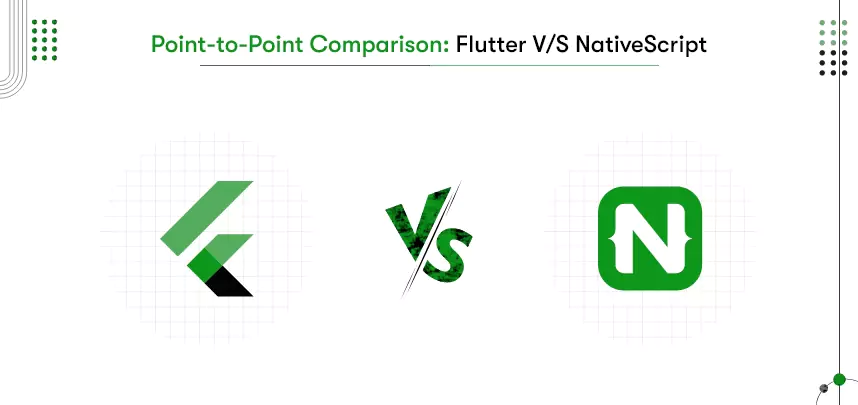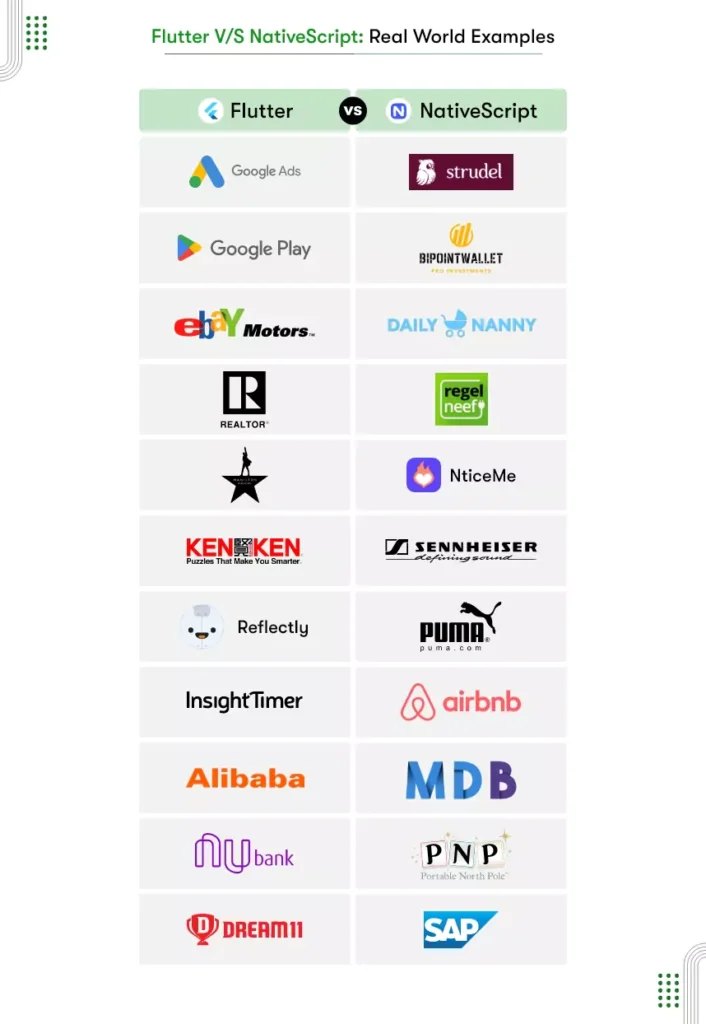Do you know why there is a rush between hiring Flutter vs. NativeScript developers among various brands?
Well, companies around the globe are relying on cross-platform app development more than ever today. As a result, the usage of cross-platform development frameworks has gone through the roof. But the existence of frameworks like Flutter and NativeScript won’t make it easy for businesses to hire the right developers.
However, these frameworks help build high-quality apps faster. They make it easier to code, improve performance, and increase the number of users your app can reach. They also help you save money by reducing the number of hours you need to spend on your app.
In addition, you get the ability to customize it to suit your needs. As a result, this leads to an increase in the number of app downloads. Down the line, companies generate more revenue and increase their brand visibility.
Still, you will now need to validate if NativeScript or Flutter developer skills are relevant to your project.
At first, it seems beneficial. But when you have to choose between Flutter Vs. NativeScript, many get indecisive. So, we have created this post, especially to save you from such a dilemma. It’s a must-to-read guide if you are on the verge of NativeScript or Flutter outsourcing.
From the introduction to performance and architecture, we’ll explore the difference between Flutter Vs. NativeScript in detail.
Therefore, buckle up!
Flutter Vs. NativeScript: The Overview
Flutter
Launched in 2018, Flutter is an open-source framework from Google to help developers build high-performing apps for about six different operating systems, including iOS and Android. It uses Google’s Dart programming language. Flutter empowers you to build modern, performant apps by reusing existing code. So you can focus on your code instead of plumbing.
The emerging Flutter framework supports a range of technologies, from the web to native, allowing you to build the app your users want. In addition, Google’s brainchild makes it easy to build complex, high-quality apps without worrying about the underlying platform.
What’s the catch? Basically, Flutter uses the strengths of native code to provide a better app-building experience than existing cross-platform frameworks and languages, such as NativeScript. With every update, Google immunes Flutter to beat all the other cross-platform frameworks in the market, extending the innovation boundary for developers. Get your hands on the latest Flutter 3.0 to know what it is capable of.
As per a survey, used by 42% of global developers, Flutter is the most popular cross-platform mobile framework.
NativeScript
NativeScript is another open-source cross-platform framework that has enabled the development of truly native mobile apps with JavaScript since 2014. In contrast to other frameworks that use Cordova rendering, NativeScript has its own rendering engine to render native-live user experience and performance.
Furthermore, NativeScript offers direct access to nearly every native platform API using JavaScript, TypeScript, or Angular. Hence, developers can leverage their web development skills to create native mobile apps. Not to mention, its wide range of templates and plugins that accelerate the app development process.
Angular and Vue.JS integration, native performance, XML for platform-independent UIs, and code reusability make NativeScript favorable and popular among enterprises and developers.

Comparison Between Flutter Vs NativeScript
After a brief overview, let us get a little deeper with a fair point-to-point Flutter vs. NativeScript.
| Fluter | NativeScript |
| It is an open-source framework, cross-platform SDK, and a UI toolkit from Google. | It is also an open-source framework for front-end, cross-platform development from progress. |
| Flutter comes with pre-configured widgets, such as buttons, tabs, and layouts that work as building blocks. | NativeScript comes with pre-configured components used for creating user interfaces. |
| You have to use the Dart programming language to build the Flutter app. | You can use JavaScript or any programming language that transpiled to JavaScript, for example, TypeScript. |
| It supports Android Studio, Xcode, and Visual Studio code. | It supports various IDEs: VS Code, IntelliJ, Xcode, and Android Studio. |
| The core concept of Flutter architecture is layers. | NativeScript supports MVC or MVVM architecture patterns. |
| Flutter supports automated testing and takes less time. | NativeScript offers default testing with its own QA workflow and takes more time. |
| Flutter has a good command-line interface with over 3200+ libraries. | NativeScript also has a good command-line interface with about 1200 libraries. |
| It has earned 142K stars on GitHub. | It has 21.3k stars on GitHub. |
| eBay, BMW, Google ads, Groupon, and more apps use Flutter. | Voice & Speech – Coach App, Roni-multiplayer game, NticeMe -Dating app, and more apps use NativeScript. |
Till now, we compared the basic aspects of Flutter vs. NativeScript. So, it’s okay if you still cannot decide. But after the upcoming differentiation, you will definitely know whether to hire Flutter developers or NativeScript developers.
Flutter vs NativeScript Performance Comparison
The different performance characteristics of Flutter and NativeScript are very apparent when you compare the two platforms side-by-side. NativeScript is faster, but Flutter app development is preferred for more performant mobile apps. Another major benefit of Flutter is that it leverages the resources of the host device. In other words, it is always working on hardware and is optimized to use as many system resources as possible on the platform.
This is because Flutter uses a hardware-accelerated Skia 2D graphics engine for rendering. Besides, it aims to provide 60 or 120 frames per second performance on devices capable of 120Hz updates.
NativeScript apps also have impressive performance and can maintain 60 FPS without any problems. Additionally, the framework takes some processes off of the frontend’s shoulders for even better performance and speed. Finally, merging manual tool instrumentation can help to further optimize and improve performance.
Architecture – Flutter vs NativeScript
Flutter uses a layered architecture, as opposed to NativeScript, which follows the MVC or MVVM architectural pattern.
Top-level root functions or platform-specific widgets are first in the hierarchy of apps made with Flutter, then come the basic widgets. Thus, Flutter is a good option for developing small to large-scale applications. Thanks to its architecture, which allows for the use of simple or complex components as needed.
What sets NativeScript apart from other frameworks is that it is built on multiple modules, each with its own functions. This also allows for a lot of customization and different types of plugins. Moreover, the framework being MVC friendly enables it to manage modules well, which in turn helps enterprise-grade applications have certain features.
Testing – Flutter vs NativeScript
It is crucial to test your app to ensure it complies with app store regulations and accomplishes successful deployment. Therefore, Flutter offers a multitude of testing features to test every widget, integration, and entire app with detailed documentation. Since it uses Dart, Flutter also supports automated testing.
NativeScript, on the flip side, has started following its own Quality Analysis workflow since the version 2.5 release. As a result, there is a significant improvement in its testing capabilities. Besides, NativeScript uses Karma for unit tests that enable continuous integration when you configure it with the unit test.
Hourly rates – Flutter vs. NativeScript
Hourly rates of developers mainly depend on the location. For example, development charges in the USA range from $90 to $150+, while in India, you can hire developers at an average rate of $30. Besides region, the discrepancies in the hourly rates are also attributed to the experience level of the developers.
If you want to find out more about Flutter developer hourly rates, here’s your cheat sheet.

Use cases Flutter vs. NativeScript
Now that you know many things about both cross-platform frameworks let’s see what they are good for.
What can you build with Flutter?
- Minimum Viable Product–MVP
- Interactive Apps with material design
- Apps for Android, iOS, Web, Windows, Desktop, from a single codebase
- Apps compatible with platform-specific features
- Advanced OS plugins with simple logic
- Apps for desktop, web, or mobile devices
- High-performing and faster apps with a Skia rendering engine
- Flexible UI with customizable widgets
What can you build with NativeScript?
- Apps compatible with massive server connectivity
- Native apps with web technologies
- Cross-platform mobile apps for Android and iOS
- Enterprise-grade apps
Pros and Cons of Flutter
Pros
- Excellent consistency of user interfaces, and business logic across multiple platforms
- Ability to simplify complex UI creation with customizable widgets
- Skia engine ensures high performance
- Hot reload feature makes development much faster
- Automated testing support
- App integration lets migrating a part or entire app to Flutter without re-writing from scratch
- Faster time-to-market
Cons
- Limited third-party libraries and plugins;
- Lacking 3D capabilities;
- Lage file size.
Pros and Cons of NativeScript
Pros
- Makes it easy to style native apps using an abstraction of CSS;
- Extensive frameworks and plugins support;
- Allows building cross-platform mobile apps using web development skills.
Cons
- Not all user interface components are free to use;
- It’s hard to share code with web build;
- Takes a long time to test apps;
- Low response time to new android features;
- Poor and sometimes buggy plugin support.

So, which one should you choose for your project?
Flutter and NativeScript are two frameworks that let you build cross-platform mobile applications. However, despite being new comparatively, it is clear how Flutter has gained progressive momentum. From performance, functionality, and compatibility to brands, Flutter surpasses NativeScript. However, for developers who know JavaScript and its frameworks well, you can opt for NativeSCript to get started building native apps quickly.
For confused enterprises and entrepreneurs, we would recommend consulting tech geeks to help you choose the best. Because it is crucial to analyze your requirements from a technical perspective to choose the right tech stack. And if you are sure about Flutter, your next job should understand the cost of and how to hire Flutter developers.













 Contact Information
Contact Information